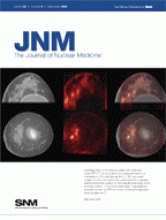Abstract
The CD20 cell surface antigen is expressed at high levels by over 90% of B-cell non-Hodgkin lymphomas (NHL) and is the target of the anti-CD20 monoclonal antibody rituximab. To provide more sensitive, tumor-specific PET imaging of NHL, we sought to develop PET agents targeting CD20. Methods: Two recombinant anti-CD20 rituximab fragments, a minibody (scFv-CH3 dimer; 80 kDa) and a modified scFv-Fc fragment (105 kDa), designed to clear rapidly, were generated. Both fragments were radiolabeled with 124I, and the minibody was additionally labeled with 64Cu (radiometal) after conjugation to 1,4,7,10-tetraazacyclododecane-N,N′,N″,N′′′-tetraacetic acid (DOTA). The radioiodinated fragments and the radiometal-labeled minibody were evaluated in mice as small-animal PET imaging agents for the in vivo imaging of human CD20–expressing lymphomas. Results: Rapid and specific localization to CD20-positive tumors was observed with the radioiodinated fragments. However, the tumor uptake levels and blood activities differed, resulting in different levels of contrast in the images. The better candidate was the minibody, with superior uptake (2-fold higher than that obtained with scFv-Fc) in CD20-positive tumors and low uptake in CD20-negative tumors. Ratios of CD20-positive tumors to CD20-negative tumors at 21 h were 7.0 ± 3.1 (mean ± SD) and 3.9 ± 0.7 for the minibody and scFv-Fc, respectively. The ratio achieved with the 64Cu-DOTA-minibody at 19 h was about 5-fold lower because of higher residual background activity in CD20-negative tumors. Conclusion: A radioiodinated minibody and a radioiodinated scFv-Fc fragment produced excellent, high-contrast images in vivo. These new immunoPET agents may prove useful for imaging CD20-positive lymphomas in preclinical models and in humans with NHL.
Footnotes
-
Guest Editor: Kenneth T. Cheng, National Institutes of Health
-
COPYRIGHT © 2009 by the Society of Nuclear Medicine, Inc.







